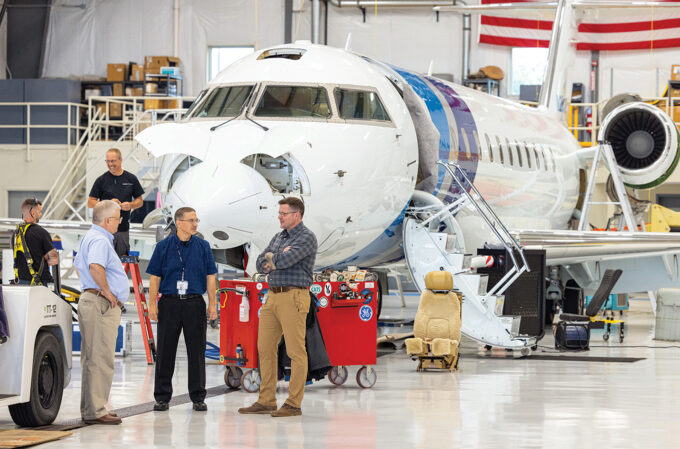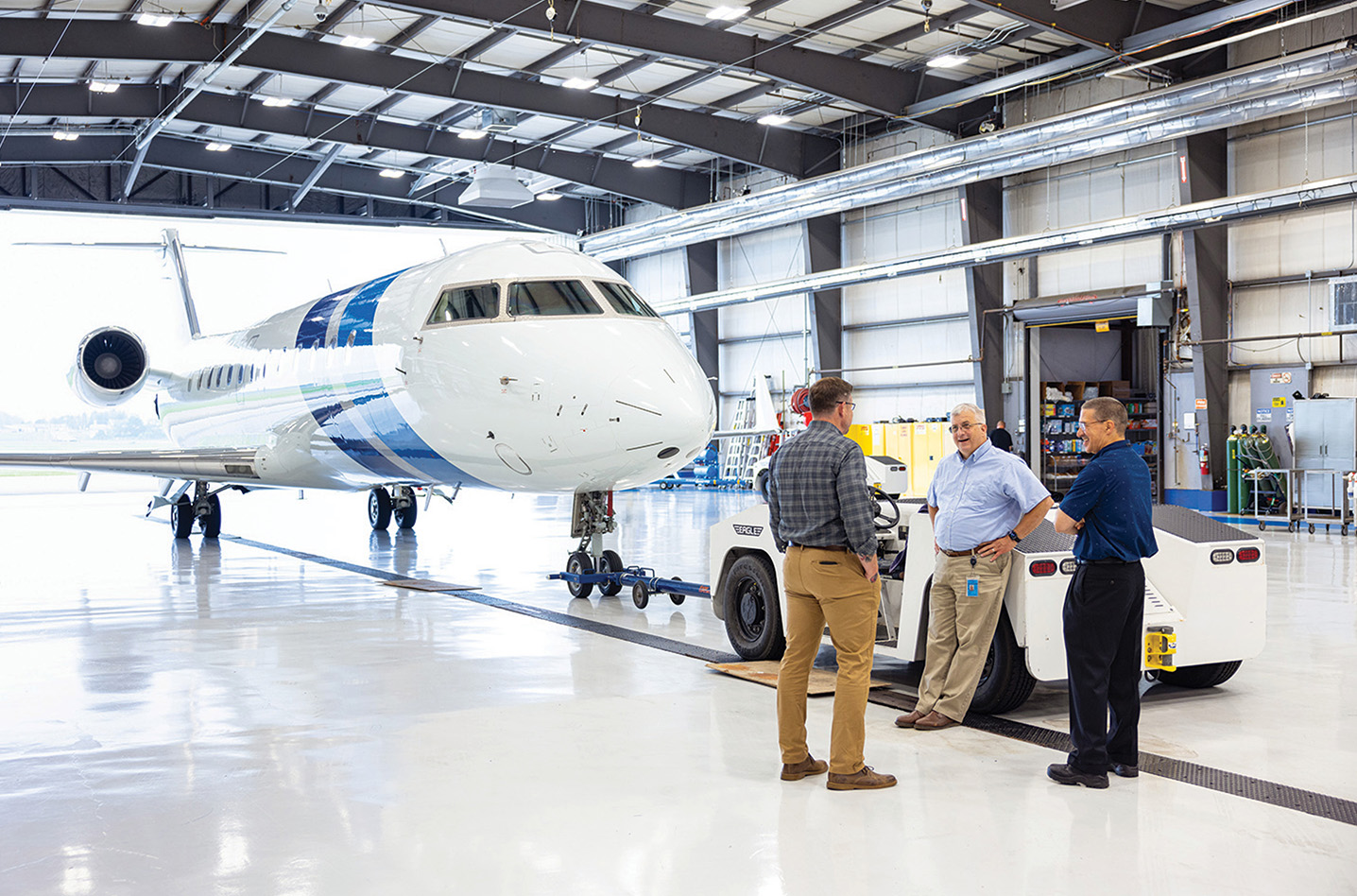Before 7 a.m., the first of nearly 30 passengers arrive. Pilot Jennifer Bruce checks them off as they gather in Corning Aviation’s lobby, while Shawn Alberg, her copilot down to Charlotte, NC, this morning, loads luggage onto the waiting Challenger 850 and starts the preflight checks. A second shuttle, to Morristown, NJ, is loading at the other end of the ramp.
In the hangar next door, technician Michelle Conklin – just eight months on the job and their newest hire – begins the days-long process of removing the fuel box from another Challenger for a structural inspection. Meanwhile, Director of Aviation Jeffrey Sharp is reviewing updates to the online training module for deicing and planning next week’s mission to Stuttgart.
“It’s like a machine. Each part knows its function and does it. And because they are all experts in their field, they manage their own affairs.”
Jeffrey Sharp Director of Aviation
The morning shuttle departures are the first of 14 movements Corning will see this day at Elmira Corning Regional Airport (ELM) near Corning, NY.
“This goes on every day here,” says Sharp. “It’s like a machine. Everyone knows their role and does it. And because they are all experts in their field, they manage their own affairs. Everybody has a lot of practice keeping it moving.”
A lot of practice, indeed. Corning earned NBAA’s 75-year Flying Safety Award in 2022. Founded in 1851, the Fortune 500 company has relied on business aviation for decades to connect both executives and employees to their global headquarters and research hub in one of the most remote areas of the Eastern U.S. The remote nature of Corning’s location makes business aviation a necessity.
In-House Repair Station
Corning flies three Dassault Falcon 900EX EASy jets and three Bombardier Challenger 850s. The Challengers serve five shuttle destinations: Charlotte, Raleigh and Wilmington in North Carolina and Lexington, KY, which is near Corning’s manufacturing facility in Harrodsburg. The Morristown shuttle, to offices in New York, goes twice a day.
On average, the six aircraft fly 3,500 hours per year. They are maintained by a team of 15 technicians and line personnel. Corning has its own Part 145 certificate, which effectively allows it to run a repair station – for its own fleet.
“Under Part 145, we can accomplish everything from line maintenance to major repairs and alterations,” says Norm Theetge, director of maintenance. “Our people have years of training under our belts, so we’re trusted to run the organization the way it needs to be. The company understands what it takes to operate at this level.”

Corning Aviation's six business jets are maintained by 15 technicians and line personnel.
The Corning team will do everything up to a 6,400-hour “4B check” on the Falcons and a 24-month inspection on the Challengers in-house. They have swapped engines, taken landing gear off and flown technicians to respond to aircraft-on-ground (AOG) events.
At 1:30 p.m., the afternoon maintenance shift arrives and joins a turnover meeting with the morning shift, to review any changes to the flight schedules, repairs in progress and squawks that may have been reported. They do this meeting every day.
“We have several Falcon master techs on staff. Everything we do is dual inspection, so every task a technician does, an inspector follows behind and signs off,” Theetge says. “Our techs are not required to have IAs [inspection authorizations], but they love going to training and take great pride in what they do.”
Self-Motivated Experts
To pass along that expertise – Corning’s most senior technician has been there nearly 30 years – Theetge pairs every new hire with a mentor. “It’s learn-as-you-go, but with a very formal curriculum,” he says.
New pilots are paired with mentors too. Every pilot at Corning is on track to become a captain on models of both aircraft. After earning their first type rating, new pilots spend about a year swapping seats with a captain, then go to training for their second type rating.
Pilots also have a variety of leadership roles to fill: standards captain, training coordinator, safety officer, the new pilot hiring team and many others.
“It’s a structured organization, and as leaders take on roles and responsibilities, that’s how they develop,” says Chief Pilot Doug Boor. “They keep themselves busy.”
“We call it a ‘self-dispatch operation.’ The pilots are in charge of everything. They’ve got to be self-motivated because they plan all aspects of the trip.”
Doug Boor Chief Pilot
One of the more demanding roles is the eight-person crew scheduling committee. Neither Sharp nor Boor assign crews to flights on Corning’s schedule – the pilots crew every flight themselves.
As Boor sees it, the pilots know best which schedules are more demanding, and who is the most rested.
“We call it a ‘self-dispatch operation,’” Boor explains. “The pilots are in charge of everything. They’ve got to be self-motivated because they plan all aspects of the trip. Sometimes they’ll make an airport call. If the ceilings are low and the winds are high, they might determine it’s safer to go into a commercial airport instead of the local reliever, and use a longer runway.”
Open to Everyone
The shuttles are open to any employee in the company and have carried more than 22,000 passengers, connecting the company with distant plants and bringing global employees to headquarters.
The company moved to the town for which it is named in 1868 and remains the largest employer in the region by far.
Many people know Corning for Pyrex, a brand the company sold off in the late 1990s. Thomas Edison’s electric light bulb included handblown Corning glass. And every iPhone has a screen made of Corning’s Gorilla Glass. Recently, the company produced millions of shatter-resistant vials for COVID vaccines.
“Access to waterways and rail systems was a key factor in bringing the company to upstate New York where we became one of the world’s leading innovators in materials sciences,” explains Tess Sydlo, who works in corporate communications. “It’s a small town, and a great place to raise a family, and that’s what keeps us here.”
“We allow Corporate Angel Network (CAN) to book four seats in advance when we open up for business travel. Memorial Sloan Kettering is one of the biggest destinations and most days, if we have a flight, we have a CAN passenger on there.”
Amy Tingley Operations Supervisor
Retired Corning employees can use the shuttles, if seats are not filled by business travelers. Seats are also open to community members flying for cancer treatment.
“We allow Corporate Angel Network [CAN] to book four seats in advance, when we open up for business travel,” says Operations Supervisor Amy Tingley. “Memorial Sloan Kettering [Cancer Center] is one of the biggest destinations, and most days, if we have a flight, we have a CAN passenger on there.”
Embracing Standards
Corning partnered with software developer PFM to launch a custom shuttle booking portal. Other aviation processes have shifted to digital tools to support things such as training, its safety management system (SMS) and flight planning.
“There’s been a big move here towards efficiency,” says Sharp, “but there’s still a lot of human interaction to make sure everything is right. Now we’re operating at the same level as an airline, and a lot of what we do, as managers, is refine it over time, constantly evaluating it and tinkering with processes to make sure they work.”
“From the outside, I’m sure it looks complicated,” says Theetge. “There’s a lot of moving pieces, but we have a really good team of people here, and everybody functions as a whole.”
Talking Openly About Safety

Before Jeffrey Sharp arrived at Corning in 2013, participation in the FAA’s Aviation Safety Action Program (ASAP) was not prevalent in business aviation. “I don’t think anybody had heard of it here, but we have it now, and we’re sharing information all the time,” the director of aviation recalls.
Through ASAP, flight crews can report discrepancies and mistakes in exchange for leniency and access to the FAA’s constantly-updated database of known safety issues, the Aviation Safety Information Analysis and Sharing (ASIAS) program.
“It’s not punitive, so people voluntarily disclose irregularities, and that information can help everybody and improve safety,” says Sharp. “The FAA can look at trends: Why are there so many altitude busts over this fix? Maybe pilots aren’t paying attention. Or maybe there’s something wrong with this procedure.”
With Corning’s Stage 3 certification with International Standard for Business Aircraft Operations (IS-BAO), aviation personnel regularly report hazards. The principles of ASAP encourage even more reporting.
“People are surprisingly willing to put reports in, because they understand it’s helpful,” says Sharp. “They feel free to come to us and talk about anything. We keep the reports anonymous, even within the department, but most of the pilots and techs will just come right out and tell you. We love that they do that.”
Snapshot: Corning Aviation
Aircraft: Three Dassault Falcon 900EX EASy jets and three Challenger 850s
Base: Headquartered at Elmira Corning Regional Airport (ELM)
Personnel: 23 pilots, 15 maintenance technicians and line personnel and four operations coordinators, including the aviation leadership team



 International Business Aviation Council Ltd.
International Business Aviation Council Ltd.